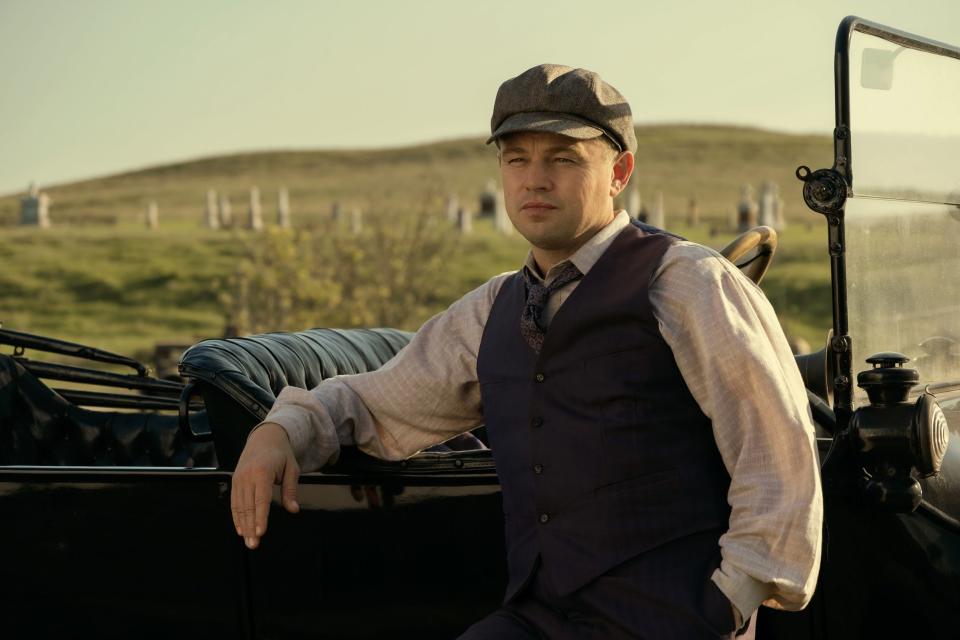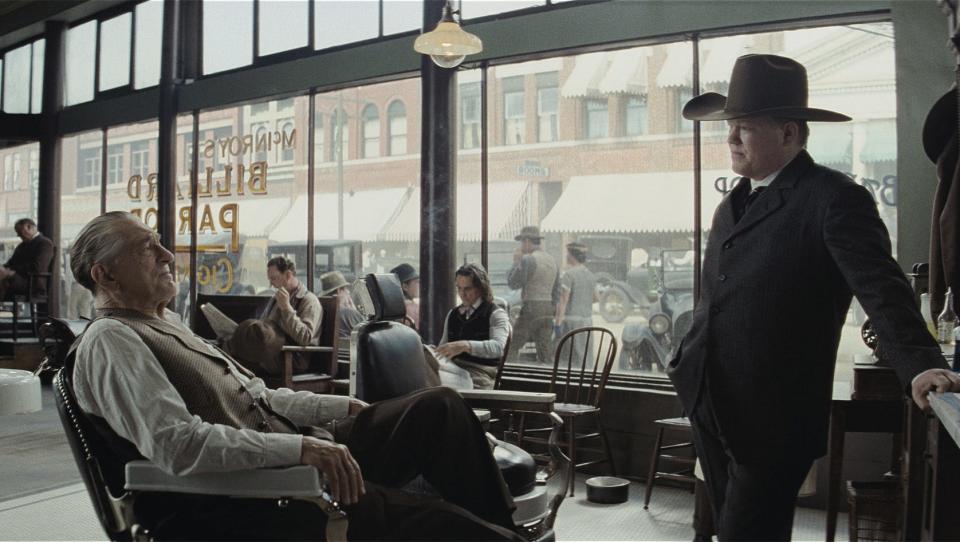Leonardo DiCaprio says 'remnants of the Osage Reign of Terror' linger in Oklahoma
- Oops!Something went wrong.Please try again later.
- Oops!Something went wrong.Please try again later.
- Oops!Something went wrong.Please try again later.
- Oops!Something went wrong.Please try again later.
For Leonardo DiCaprio, the marks left by the Reign of Terror were apparent when he got to Oklahoma to work on "Killers of the Flower Moon."
"The residue and the remnants of the Osage Reign of Terror is generational, and it's still evident within the communities there in Oklahoma. We were there a century later, and a lot of the injustices are still occurring to this day," DiCaprio said this week during a virtual press conference for the film.
"What is fascinating to me about this story is we think this is a century old, but places that are rich in most resources are often most drenched in blood. And we see this not only in America, but all around the world. This story's a microcosm for a much larger story about Indigenous people and lands — and it's still happening today. That, to me, was one of the most shocking revelations."

'Killers of the Flower Moon' cast talks characters and collaboration after SAG strike
Since it was released in theaters Oct. 20, "Killers of the Flower Moon" has put on global movie screens a dark and often-overlooked chapter of Oklahoma history: The 1920s "Reign of Terror," a series of brutal murders of oil-rich Osage Nation citizens.
But the star-studded cast of writer-director Martin Scorsese's $200 million cinematic epic has been unable to promote the film since shortly after its May world premiere at France's Cannes Film Festival because of the 118-day Screen Actors Guild strike.
With the successful end of the strike, DiCaprio joined co-stars Lily Gladstone, Robert De Niro and Jesse Plemons, along with Scorsese, Wednesday for a 30-minute Zoom conference with journalists.
Filmed in and around Osage County in 2021, Scorsese's movie is adapted from David Grann's 2017 best-seller “Killers of the Flower Moon: The Osage Murders and the Birth of the FBI." The movie focuses on Mollie Kyle Burkhart (Gladstone, who is NiMíiPuu, or Nez Perce, and Siksikaitsitapi, or Blackfeet) a real-life Osage woman who, along with her family, was marked for death in a vicious scheme to swindle away her oil money.
Also an executive producer on the film, DiCaprio portrays Mollie's treacherous husband, Ernest Burkhart, who gets caught between his love for his wife and the ruthless schemes of his powerful uncle, William K. Hale (De Niro). Plemons plays Tom White, the agent who leads the eventual federal investigation.

The actors and Scorsese talked about digging into the characters, working with the Osage Nation and telling the complicated story. Questions have been edited for length.
Q: The filmmakers worked hand in hand with the Osage Nation. ... Can you talk about the importance of this?
Gladstone: I mean, it was everything — and I'm sad that that hasn't been the precedent this whole time. ... I often play roles from tribal nations that I'm not from, and ... I definitely go through an acculturation period.
On some other films I've done — not this one — people just take for granted that there are 574 different federally recognized nations in the United States. We're not a monolith, and we're not homogenized. I speak some Blackfeet language from where I grew up — I grew up on my father's reservation (for) one of his nations — but Osage is a foreign language to me. And a lot of people assume that Native actors just know how to speak the Native American language. ...
What was wonderful was that production, for such a long time before we ever got there, were building these relationships with the community. So, by the time I arrived, there were already a lot of people that were willing to meet ... to really work with me on how an Osage woman at the time would have conducted herself. ...
The most important element of all of it, for me, was that I was never alone on set. If I was uncertain about a choice I was making, there was not just one but several Osage people in every level of production close at hand.
Q: Bob and Leo, because you have both worked with Mr. Scorsese before, what is it about him that makes you keep coming back?
De Niro: Well, it's always been just easy and gratifying. ... We've found projects; we do 'em. It's always been great. So, I've been very lucky to have been able to do 10 movies with Marty — and hopefully we'll be able to do a couple more.
DiCaprio: These two men that we're speaking to have been like cinematic father figures to me ... and it's been this amazing experience to be able to work with both of them together. ...
I just remember those moments that we all had talking about the final way that this relationship between Hale and Ernest would culminate. ... I just remember fondly those rehearsals that we had together, because it was an amazing creative process to get to that moment. And it could only happen with these two cinematic heroes of mine. They kept hammering home, 'What is the truth of their dynamic?' over and over again — and we got to that moment.

Q: Jesse, how was it for you to work with these giants?
Plemons: As Lily said, by the time I showed up, it was so apparent how much work had already been done. ... But my experience working with Marty and these guys, it's there's this constant exploration and constant search for finding the essence of what's really happening in this scene. ... It's a process, as it always is, but a fun one.
Q: For Mr. Scorsese, can you discuss your creative decisions and how you wanted to tell this story in both a historically accurate and emotionally resonant way?
Scorsese: Myself and (cowriter) Eric Roth, we had taken over a period of two years working on the script, during which time I did 'The Irishman.' ... And I got to know a lot of the Osage people, because I kept going back to Oklahoma. And I kept hearing stories, and they kept speaking about this — because the families are still there — that ... Ernest and Mollie were in love. And that a lot of these deceptions and betrayals and murders came out of people who really liked each other. ...
We really couldn't get into the very real or the true nature of what this tragedy was (until) Leo said, 'Where's the heart of it?' And I said, 'Well, the heart is that Mollie and Ernest are in love.' ... And then we really got to work.

Q: Leo and Lily, The dynamics of your characters' relationship is so complicated. Can you share what you learned about Mollie and Ernest's relationship?
Gladstone: One of the first times that we had gone out in the community together was to sit with Margie Burkhart ... the granddaughter of Mollie and Ernest. Her father was Cowboy, the little boy that you see in the film. ... Where we really found this evidence of this very difficult — and difficult to navigate and articulate — love story in the film, it was in the evidence of the legacy they left.
DiCaprio: As bizarre and twisted as it was, they really did have an amazing connection together. ... It's based in a sense of community from the Osage of a story that, in a lot of ways, they have not openly talked about.
So, here we were 100 years later, bringing up these ghosts and the stories from the past in the actual locations, and working with direct descendants of this tragedy. So, all I can say is it was an honor to be a part of this movie and telling the story. ... I just felt tremendous gratitude and appreciation that we got to tell this forgotten part of American history — and that just led us on a journey to tell the truth about who these characters were.
This article originally appeared on Oklahoman: 'Killers of the Flower Moon' cast talk about film post-SAG strike

